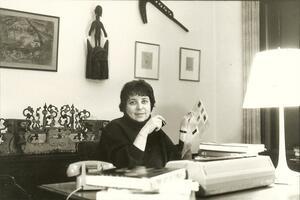Death of Artist and Photograph Editor Sally Fox
If a picture is worth a thousand words, Sally Fox was one of the most vocal figures in women’s history.
"I am driven to try to document what women are really doing, so they won't be taken for granted," Fox said in a 1990 interview with the Boston Globe.
Fox worked on the theory that graphic images in drawing, painting, photography, and sculpture revealed more about the real life of a culture than the written history of the time, which was mostly written by and from the perspective of men. She collected thousands of images of women at work and at leisure. At the age of 66, she shared the first of her findings in The Medieval Woman: An Illuminated Book of Days (1985), which sold over 300,000 copies and was translated into eight languages. She followed this bestseller with The Victorian Woman: A Book of Days in 1987 and The Sporting Woman: A Book of Days in 1989. Renowned for her diligence, skill, and commitment to mentoring young picture researchers just entering the profession, she was awarded the Ann Novotny Award for Original Picture Research by the American Society of Picture Professionals in 1987.
Born to professional musicians (both émigrés from the Russian civil war) Salomea Cherniavsky was born in Hollywood, California, in 1929. When her family moved to New York, she attended the High School of Music & Art and Performing Arts, graduating in 1947 and received a BA in painting and art history from Queen's College. After working as a librarian and publicity director for the Museum of Modern Art (MOMA) and at the Archives of American Art, Fox moved to Brookline, Massachusetts, with her husband, Maurice Fox, and their three sons. There she worked 15 years for Houghton Mifflin, first as a freelance photographer, then as the coordinator of picture research and picture editor.
Following the success of her book on sporting women, a traveling exhibit drawn from her collection, The Sporting Woman: InSights from the Past, was displayed at museums and universities across the country during the 1990s. "The idea is to show women have participated in sports throughout history," she told the Globe. "You don't read about it. History is written by men. So I concluded it can be documented only by pictures."
Fox stood as a pioneer who helped gain recognition for the then-emerging profession of picture research and the necessity of incorporating images in historical research. In 2005 she donated her collection of thousands of images to the Schlesinger Library.
"She was a pioneer," said Kathryn Allamong Jacob, curator of manuscripts at the Schlesinger Library at Harvard University. "She had a wonderful eye for reading photos, and reading photos with a feminist eye."
Sources: Sally Fox Collection, Arthur and Elizabeth Schlesinger Library on the History of Women in America, Radcliffe Institute for Advanced Study, Harvard University; Boston Globe, March 2, 2006.



